
24 Jul Constructing God of Money
by Maguma
God of Money was made possible by a series of happy circumstances.
In 2014, during the celebration of the International Illustration Festival, Ilustratour, I met Gita Wolf, director of Tara Books. My work appeared very witty to her and we had an interesting conversation thereafter.
Several weeks after that fleeting meeting I received an email from Gita with a very interesting proposal and a great challenge: What if we made an illustrated book that dealt with a political issue and one that connected with contemporary social reality? Wow! What a challenge!
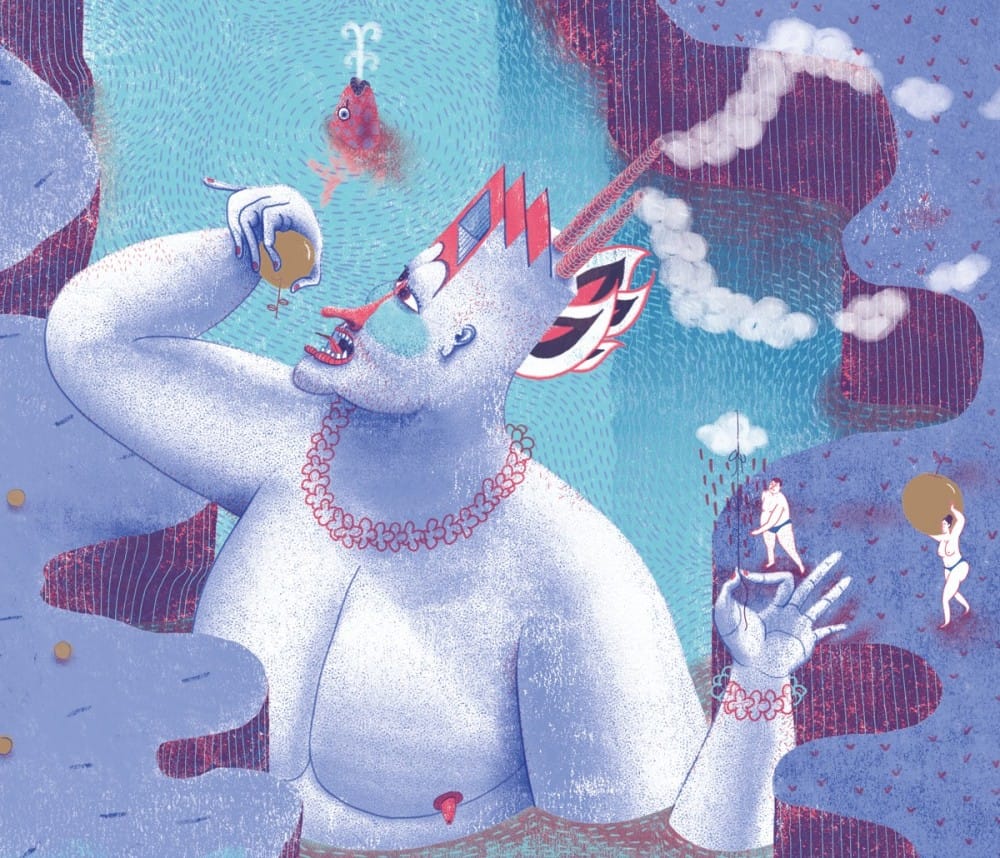
An image from God of Money
Tara Books is an independent publisher based in India. It is a collective of writers, designers and book artisans who favor a non-hierarchical mode of functioning and are focused on experimentation — to do with content, design and production, creating in the process books that are of excellent quality and with committed and critical content.
Gita had seen the work I do for print media, that is, the political press, in which I mainly deal with political, economic and social issues. She thought that the visual conception which shaped these images could be transferred to the pages of an illustrated album.
And the good news didn’t end there: she also offered me the opportunity to work with the rest of the Tara Books team in India. I couldn’t believe it! It was a great opportunity and an exciting project too! Although we were not sure yet what the book would exactly be about, I accepted the invitation enthusiastically.
Many months passed, almost a year, and we still didn’t have the project defined, but we did work at and complete all procedures that would enable me stay in India for two months. It all appeared imminent.
At that time I began to correspond by email with V. Geetha, writer, feminist activist and editorial director of Tara Books. We discussed and evaluated the possibility of my working with some rather unusual texts: in this instance, Karl Marx’s Economic and Philosophic Manuscripts of 1844, also called The Paris Manuscripts, which contain an initial outline of some of his latter day theories and were written when he was only 25 years old. An illustrated album with texts by Karl Marx and talking about economics? Why not? Besides, when he wrote those texts he wasn’t Marx yet; at least not the Marx that everyone knows. His way of thinking overflowed with passion and immediacy.
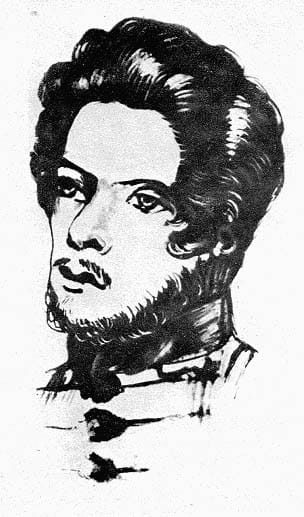
Portrait of the young Marx
In early July 2015 I landed in Chennai, ready to unravel the words of Marx and I found a world full of contrasts and totally alien to what I had lived until then. Later on, that world would wrap everything up, even the book itself.
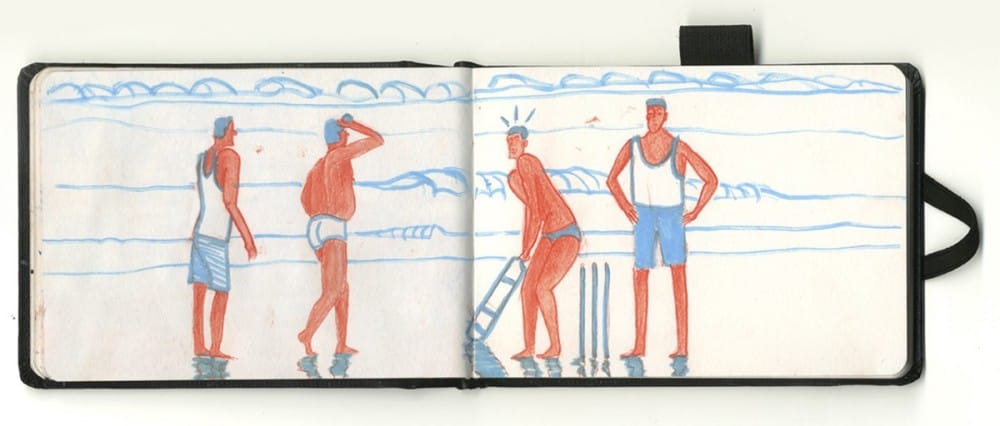
Playing Cricket at Thiruvanmiyur Beach
During my early days there I met V. Geetha, Arumugam, Lalitha and the rest of the publishing team and I took the opportunity to get a closer look at their screen printing workshop, where they produce wonderful handmade books, made with handmade paper and bound by hand.
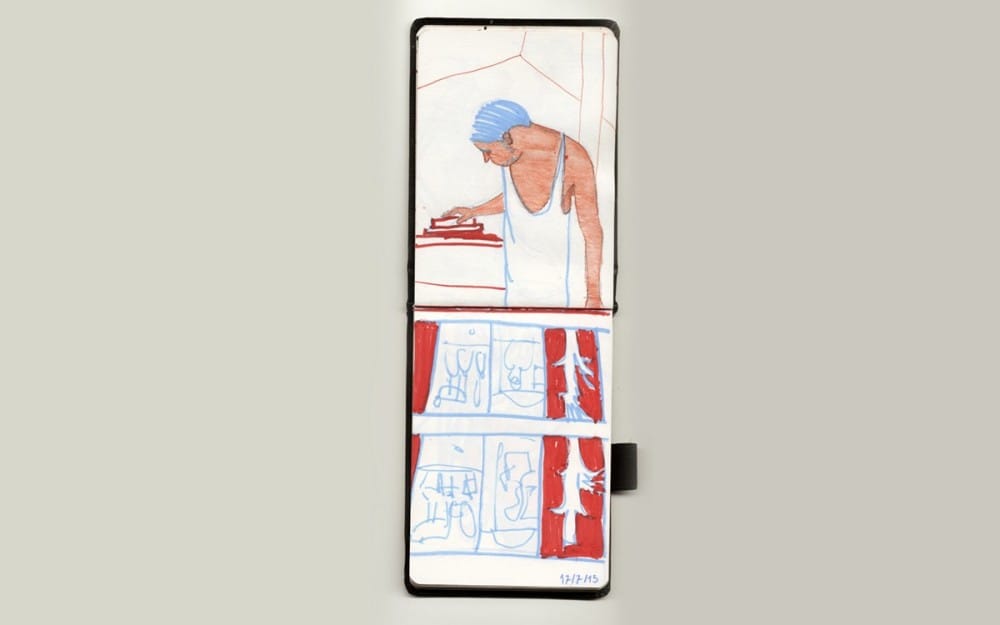
Stamping with teak wood blocks on fabric
Over those first days we talked a lot about Marx’s texts and soon it became clear that the manuscripts were like a puzzle that had to be ordered and hierarchized and that what we wanted to communicate would require the text to be wrapped around one theme — money.
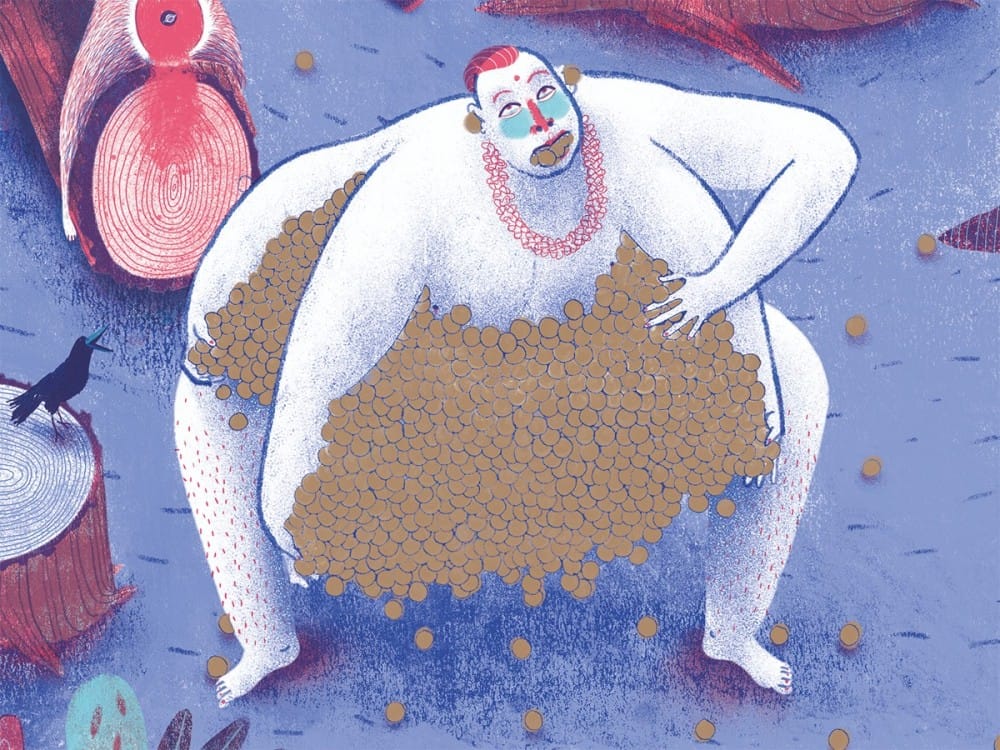
An image from God of Money
Laila, a Belgian friend of Berber origin who lives in Chennai, told me that India is like a mini planet earth. Almost identical to the one we know, but smaller than the original. And so, in India as on earth, many religions coexist (that is, they more or less coexist), there are many different races and languages and there is an inequality equivalent to that of the blue planet, an inequality based, ultimately, on wealth and status dependent on birth. From this point of view, I could see how money could be understood in both local and universal ways, and how the young Marx’s texts, written in 1844, be made to connect directly with this globalized world in which we live.
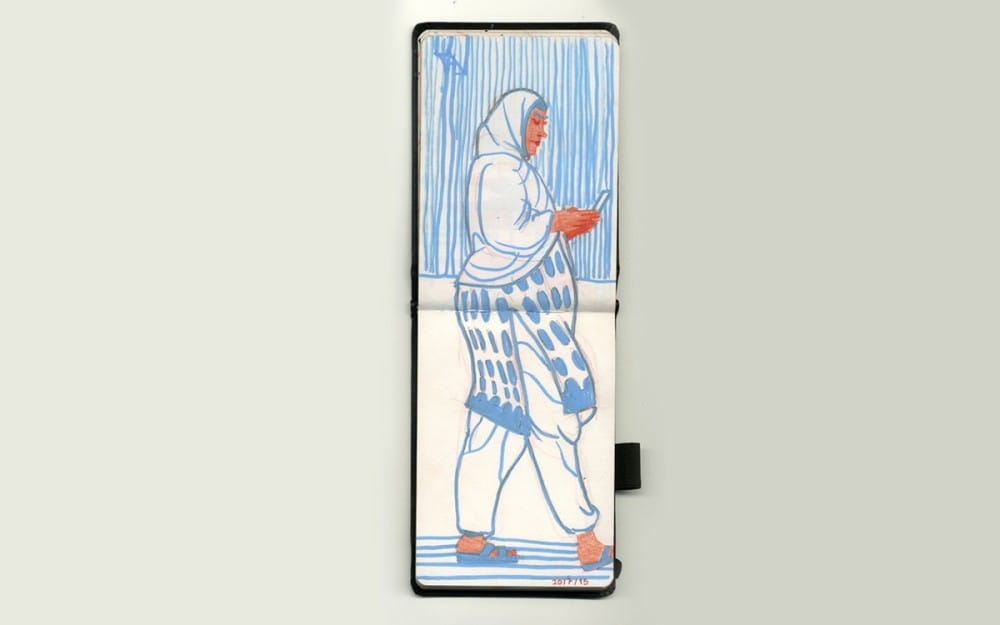
Woman looking at her mobile phone
As I saw it, from the very moment that a human being first appropriated common resources to his own use, deploying an axe to fell trees, the idea of property became real; and soon after began our obsession with money — and in a sense this goes back to our distant ancestors, and so I began to wonder if money was not the famous forbidden fruit of the Garden of Eden?
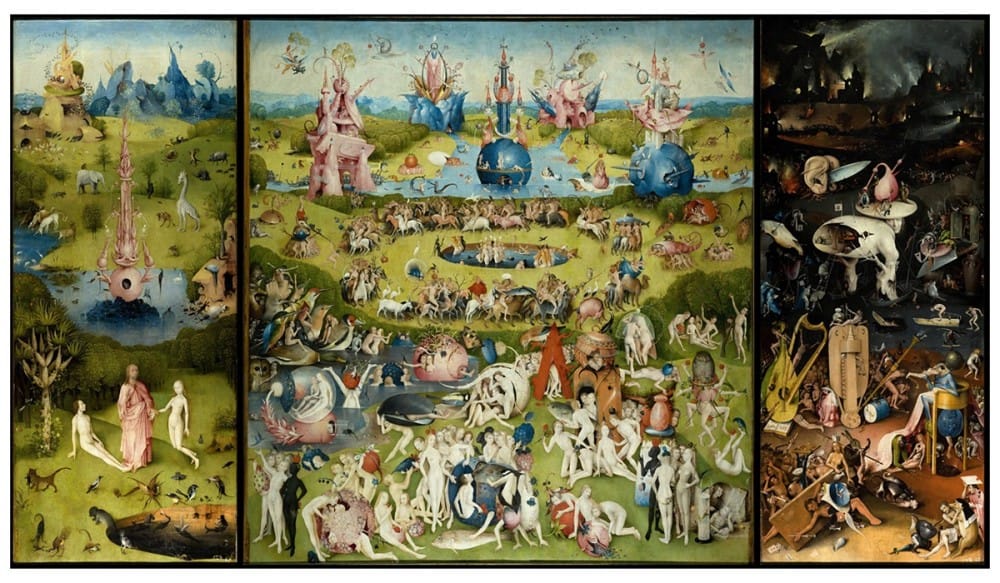
The Garden of Earthly Delights by Hieronymus Bosch
One year after my time in Chennai, with God of Money already in production, I participated in a collective exhibition which theme revolved around the work of Hieronymus Bosch. I was fascinated by his work. I could spend hours looking at The Garden of Earthly Delights. But on this occasion, when I looked at it again, I discovered something unusual: God of Money was like a contemporary version of ‘The Garden of Earthly Delights’; The work represents the Garden of Eden, Original Sin and Divine Punishment. The scenes are presented in such a way, that it is as if the observer were looking on them from above, as if he were on top of a cloud. And the work is also mounted on a wooden altarpiece with hinges, so that it can be closed and opened like a book. God of Money turned out not to be very different: it also shows the Garden of Eden, Original Sin and Divine Punishment. And although it does so in a continuous and diffused way, it is built on paper hinges, forming a leporello. But the most surprising thing is that it places the reader on top of a cloud, just like Hieronymus Bosch’s painting does.
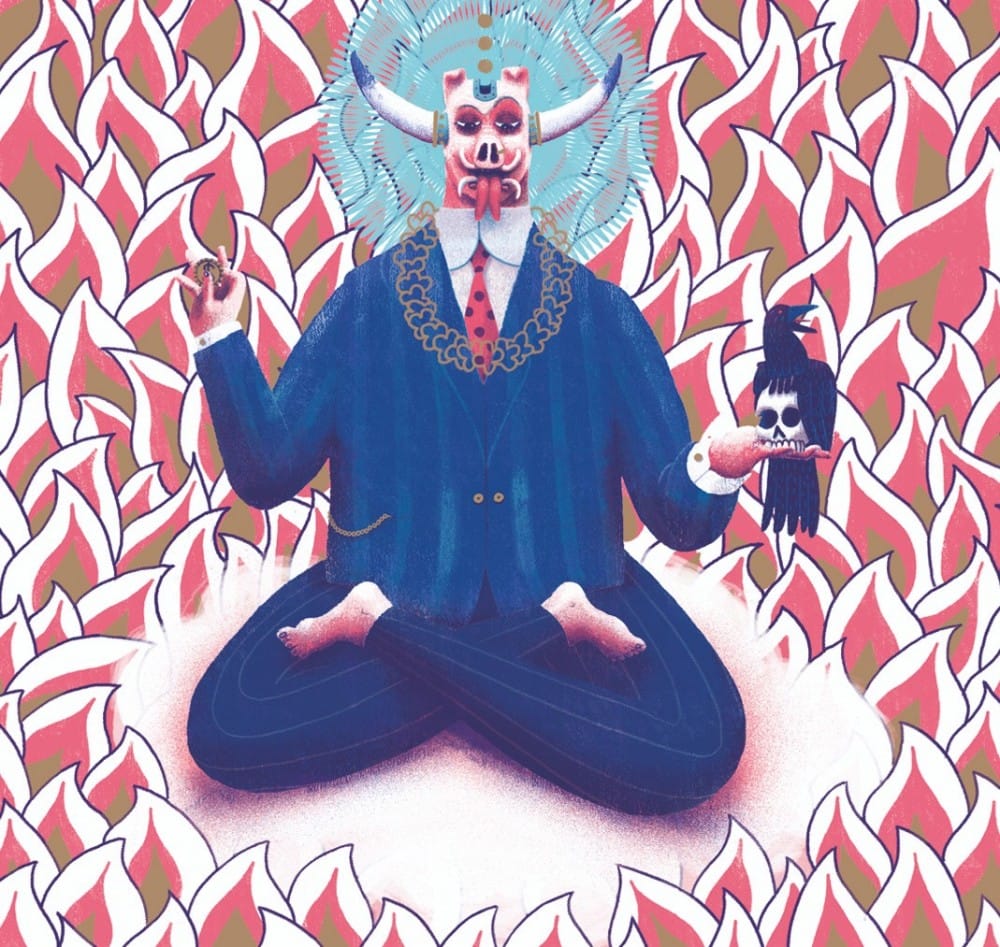
An image from God of Money
During my days in Chennai I alternated my work at Tara Books’ Book Building with long walks in which I soaked in sights, smells, noises, flavors and endless endless sensations that I began putting into a notebook that gradually was filled with drawings. Almost without realizing it, the drawings in the notebook and those in the book began to mix and the stimulating reality that surrounded me began to fade into the pages of the book. And at the same time, the sketches of the book jumped to the notebook and the environment became an inexhaustible source of inspiration.
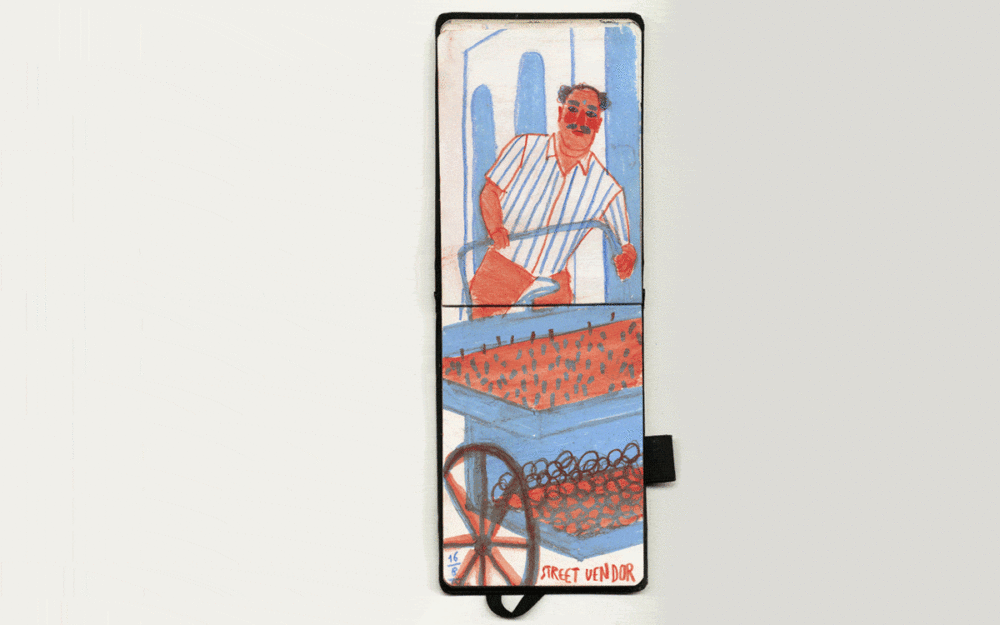
My dear traveling companion
With these ideas prowling around in my head, I came to the conclusion that I would create images that tell the story of God of Money, a disgusting and colossal animal that had emerged from the greed of which Marx’s texts spoke. But I needed to have a thread that would connect all these images.
From the beginning I was clear that I had to distance myself from the imagery of the sickle and hammer associated with Marxist parties and Marx himself. When he wrote what became the Paris manuscripts, Marx wasn’t exactly talking about Marxism yet, and so the images that illustrated their content could not be ‘Marxist’. In addition, the manuscripts were a series of reflections, which needed to be put together — one had to make a mind map to connect all of them.
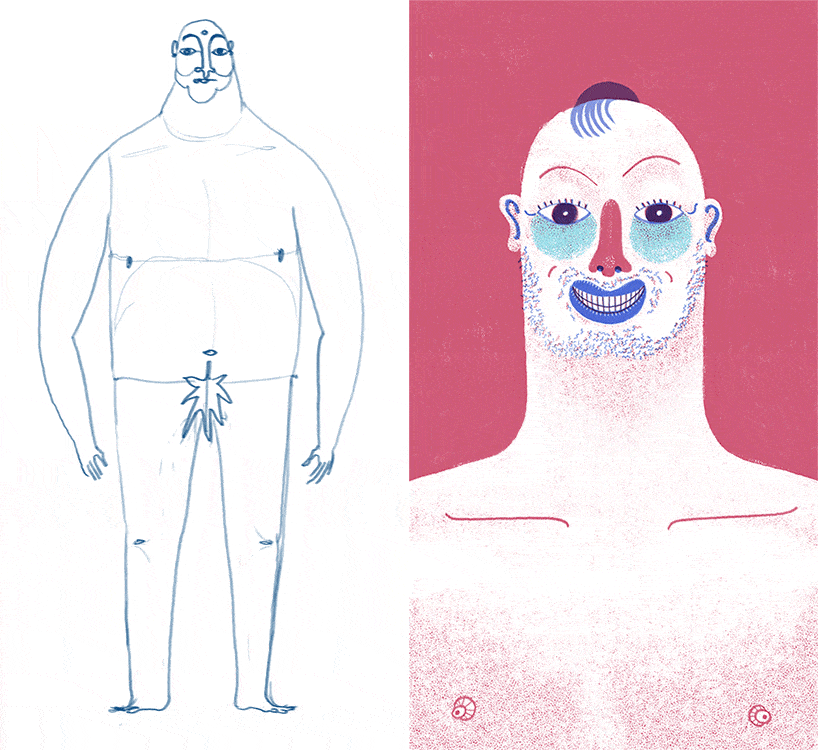
From Adam to God of Money
Further, apart from telling a story with an approach, a knot and a denouement, the images of the book had to exist in dialogue with Marx’s chaotic texts. So, after I got hold of and read the larger text from which sections had been chosen for this project, I constructed a visual map that reflected, in turn, the mental map that came to inhabit my head.
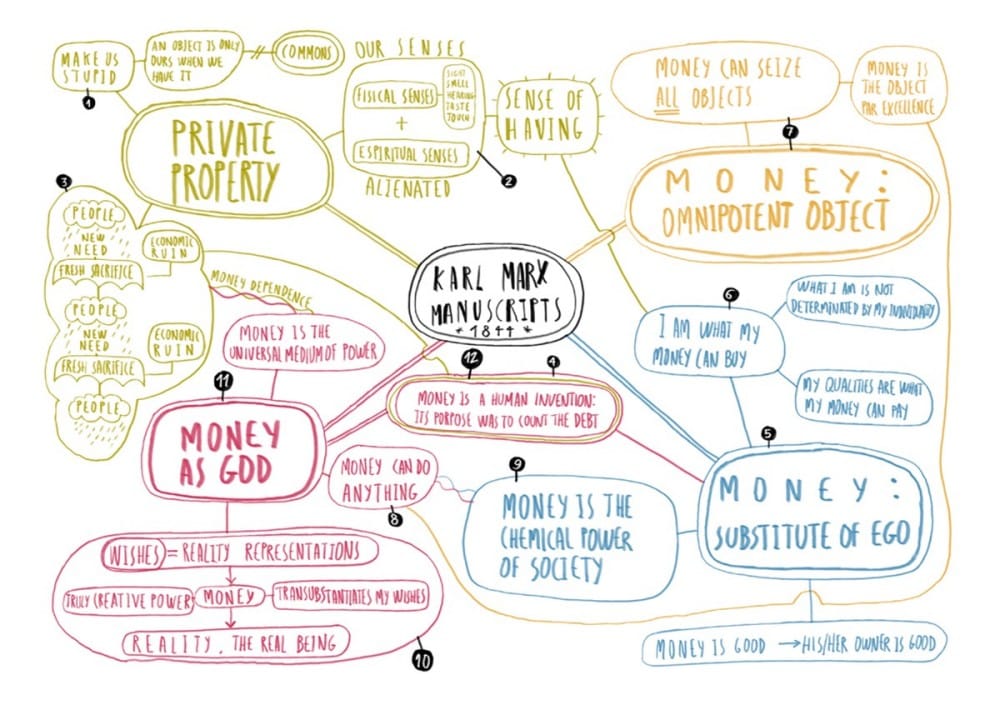
Visual map of Karl Marx’s Manuscripts of 1844
I began to making drawings with a series of predetermined rules: on the one hand, my sketches had to refer to the ideas that were shown in the manuscripts, and on the other hand, it was important not to forget that my story would begin when that first hunter-gatherer named Adam decided to use an implement that would facilitate the felling of the trees of the Garden of Eden in order to be able to appropriate the forbidden fruit (money).
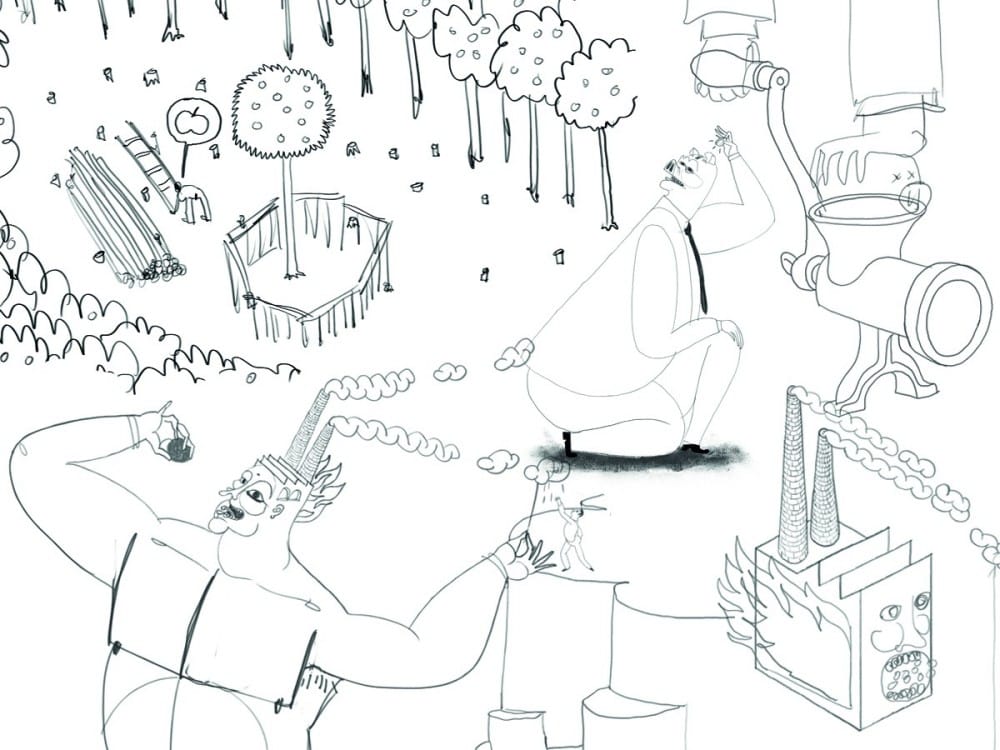
Sketches developed for the God of Money
While I was sketching and thinking about how I wanted to represent the images suggested by the texts, I realized that I was endowing the history of appropriation with a narrative structure, and each page with a visual that would represent the passionate ideas of the young philosopher. As I ordered the passages of the notebooks to relate them in a coherent way to the evolution of the God of Money in history, the book began to take shape and the map I had imagined when reading Marx’s incomplete notes become an accordion that also had the virtue of unfolding and displaying all its contents at once.
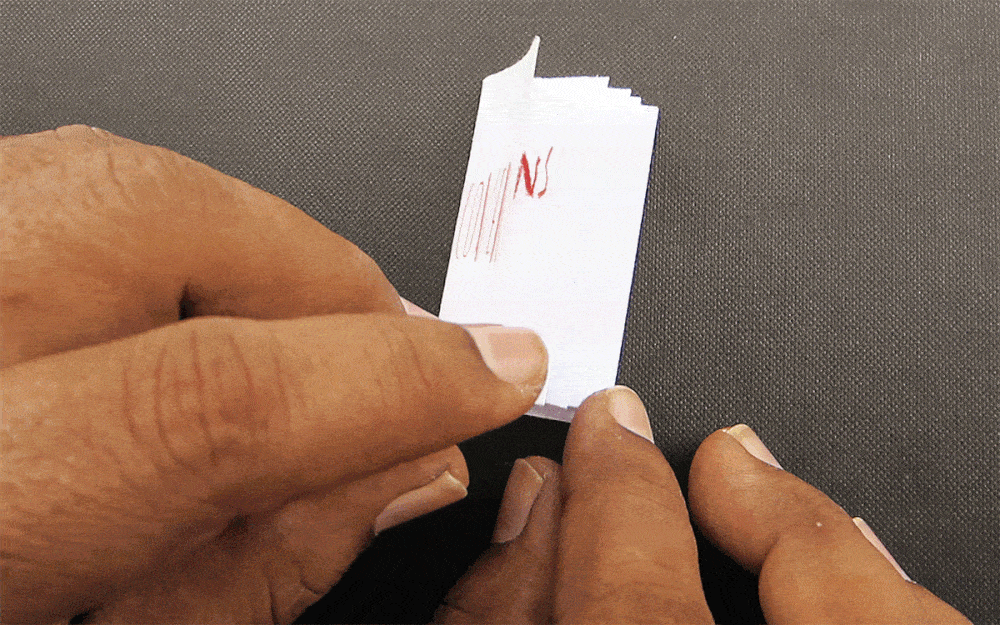
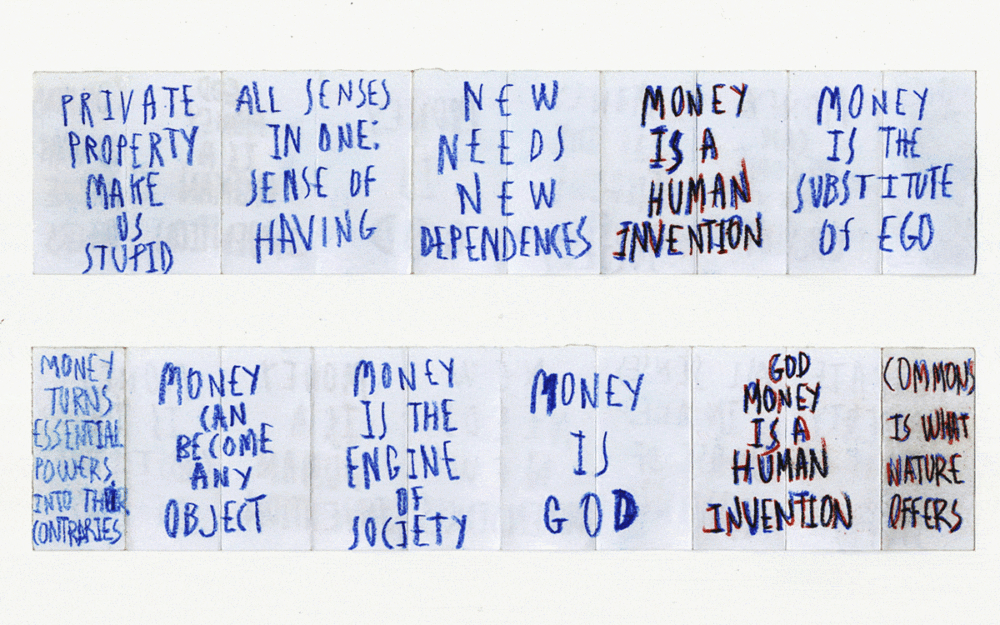
This is how the ideas of the young Marx relate to the history of God of Money

Sketch of the construction of the book
My intense days in Chennai were over and the project that Gita had proposed to me a year ago was almost finished. Chennai had been my home for two months; A gift that has given me stimulating experiences and a handful of good friends. The last day I had only one thing left to do: collect the long necklaces of fresh and aromatic flowers that the lady of the Arulmigu Marundeeswarar Temple had sewn by hand, so that my family could enjoy, for a few moments, the unforgettable smell of India.

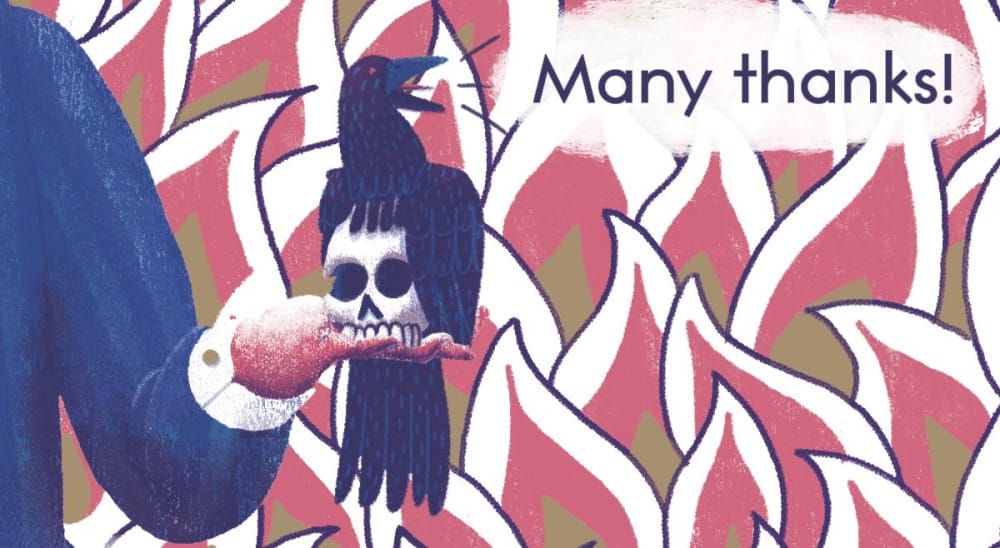
Apart from the English edition of God of Money, the book has also been published in Spanish by Libros del Zorro Rojo as El Dios Dinero, in Italian by Gallucci editore as Dio Denaro, in Portuguese by Boitempo Editorial as O Deus dinheiro, and in German by Tara Books as Der Gott des Geldes.
The many editions of God of Money
Maguma is the pseudonym for Spanish artist Marcos Guardiola Martín, who is based in Madrid and works for a growing number of publications, including dailies, weeklies and political journals across Europe and Latin America. Trained as an architect in Madrid, Maguma brings to his work a sense of space and surface that is unique. You can follow Maguma on Facebook, Instagram, Twitter and his website. Click here to discover his other Tara Books.


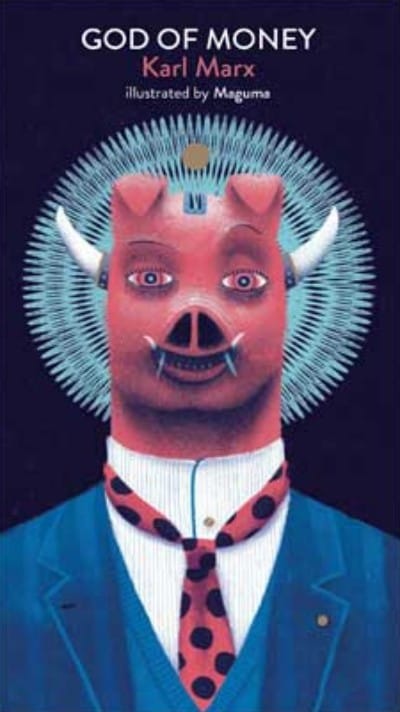
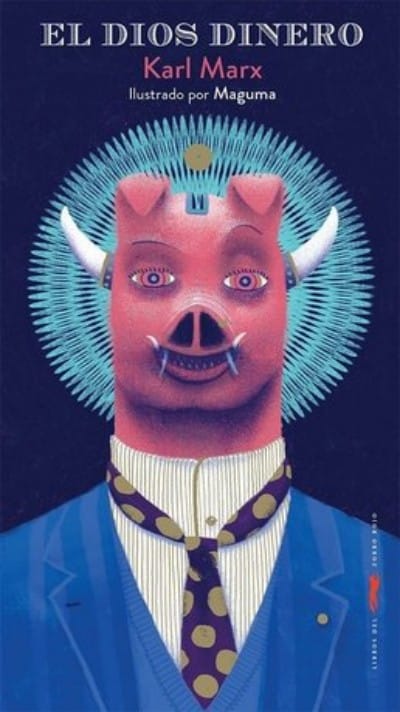


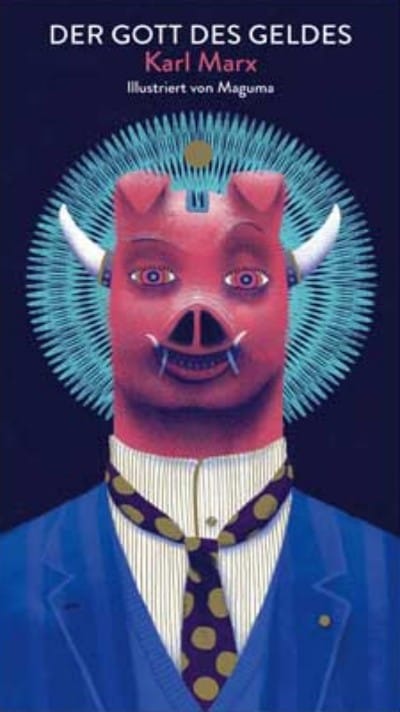

No Comments